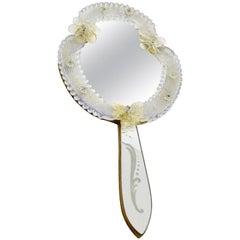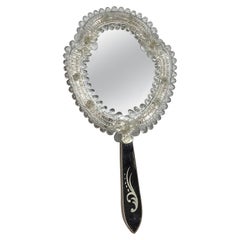Venetian Handheld Mirror
Recent Sales
Vintage 1950s Italian Hollywood Regency Wall Mirrors
Wood, Murano Glass
Vintage 1950s Italian Hollywood Regency Wall Mirrors
Wood, Murano Glass
Vintage 1950s Italian Hollywood Regency Wall Mirrors
Wood, Murano Glass
Vintage 1950s Italian Hollywood Regency Wall Mirrors
Brass
Vintage 1950s Italian Hollywood Regency Wall Mirrors
Wood, Murano Glass
A Close Look at Hollywood-regency Furniture
The California-born style of Hollywood Regency, also known as Regency Moderne, emerged during the Golden Era of cinema from the 1920s to the ’50s. Decadent and bold, vintage Hollywood Regency furniture and interiors playfully mix colors like jewel tones and hot pinks with lacquered walls, gilded accents, mirrored surfaces and metallic finishes for maximalist spaces.
Although it involved elements of the coinciding Art Deco movement, such as a preference for clean lines, Hollywood Regency was much more opulent, inspired by glamorous movie stars and the lavish set designs for films being made in Tinseltown. Furniture designers associated with the style embraced an eclectic range of influences, including throwbacks to previous styles of grandeur, such as Rococo, neoclassical and chinoiserie, as well as materials, from bamboo dining chairs to lucite bar carts to sunburst mirrors made from gilded resin. Hollywood Regency end tables, floor lamps, chandeliers and other pieces tended to be small-scale, fitting into an overall design rather than serving as a focal point.
Interior decorator Dorothy Draper led the shaping of the Hollywood Regency style and also designed iconic pieces like the España chest, which was manufactured by Henredon. Virginia native William “Billy” Haines, a furniture designer who started as an actor, contrasted hand-painted wallpaper with Chinese ceramics and Chippendale chairs, while architect John Elgin Woolf imbued his Beverly Hills designs with theatrical details. Paul Revere Williams, a trailblazing African-American architect, was pivotal in defining the look through his commercial projects, such as the 1940s Beverly Hills Hotel and bespoke homes that mixed everything from Louis XV paneling to Georgian architecture.
Find a collection of vintage Hollywood Regency bedroom furniture, tables, seating and other pieces on 1stDibs.
Finding the Right Wall-mirrors for You
Vintage and antique wall mirrors add depth and openness to a space — they can help create the illusion that a narrow hallway isn’t so narrow. But you don’t need hundreds of enormous arched French or Italian mirrors framed in gilded bronze to dress up your home (maybe just a few).
A few well-placed large wall mirrors and other types of mirrors can amplify lighting and help showcase the decorative and architectural features of your home. For the Palace of Versailles during the 17th century, French King Louis XIV ordered the construction of the Hall of Mirrors after spending millions of dollars importing expensive Venetian mirrors from the revered glass-blowing factories on the island of Murano. A mirror-manufacturing rivalry between Paris and Venice took shape, and soon, across from 17 large windows that open out over the adjacent Palace Gardens on one side of the Hall, more than 350 mirrors — large mirrors made of groupings of small panes — were installed, effectively bringing the radiant colors of the outdoors into the opulent corridor.
Wall mirrors for your living room can work miracles — pull your landscaping’s colors and textures indoors, Louis XIV–style, by covering the length of an interior wall across from your living-room windows with wall mirrors.
For a similar effect, surrounding your mid-century modern wall mirror with leafy air plants and fern floor plants can amplify the sense of serenity that greenery offers in your home. Choose wall mirror frame styles to match your home’s decor, or shop for a frameless, organically shaped mirror that’s cut or beveled for a clean yet distinctive showpiece. For a free-spirited Bohemian feel, create a cluster of mismatched antique wall mirrors — an arrangement of circular Art Deco wall mirrors, Rococo-style silver leaf mirrors and decorative oval Victorian mirrors could add spice to an otherwise unadorned dining-room wall.
Elsewhere, there’s nothing vain about buying a full-length mirror for your bedroom, bathroom or walk-in closet to help you perfect your look for the day. Another may be needed in your entryway for a last-minute ensemble inspection. In fact, a shimmering 18th-century hall of mirrors awaits visitors behind the steel door of Stephen Cavallo’s atelier in Manhattan.
“We like to see the look on people’s faces when they walk in,” says Cavallo.
Decorating your home and office with wall mirrors is an art form in and of itself — get started today with the variety of antique and vintage wall mirrors on 1stDibs.
- What is a Venetian mirror?1 Answer1stDibs ExpertOctober 21, 2020
While polished metal mirrors have existed since ancient times, glass Venetian mirrors are thought to have first been produced on the Venetian island of Murano, in Italy, beginning in the 1500s (some research points to 1300 for Venetian mirrors). Set in ornate frames frequently bedecked with gold highlights or floral leaf designs, Venetian glass mirrors were handmade by artisans using refined, expert techniques for royalty and for members of the upper class. By the 17th century, Venetian mirrors were in high demand. Because antique Venetian glass mirrors are still very popular today, there are many knockoffs on the market. Today’s authentic Venetian mirrors are still produced only on the island of Murano.
- How do I clean Venetian mirrors?1 Answer1stDibs ExpertApril 5, 2022To clean Venetian mirrors, mix one part white vinegar with two parts warm water. Dampen a soft, lint-free cloth with the solution and wipe down the mirror. Then, wipe it again with a second cloth moistened only with water. Dry with a lint-free cloth. Find a variety of antique Venetian mirrors on 1stDibs.
- 1stDibs ExpertOctober 21, 2020
Regular glass cleaners don’t contain that much vinegar. This means that these cleaners are good for mild cleansing, but for antique glass Venetian mirrors, which tend to get cloudy, a more thorough way to clean is to use only white vinegar. Dampen a clean soft cloth with a solution of white vinegar and water (one part vinegar to two parts water) and apply to your Venetian glass mirror. After you’ve cleaned your Venetian mirror with vinegar, clean the mirror with warm water on a soft cloth in order to get rid of the vinegar smell. Alternatively, if you have difficulty with the smell of vinegar, use rubbing alcohol instead (but be sure that you’re only applying these methods to the glass rather than the frame).
- 1stDibs ExpertOctober 21, 2020
Repairs and replacements can go toward devaluing any piece of antique or vintage furniture, and any modifications or repairs done to a centuries-old mirror should be handled by experts and executed with care. Because antique Venetian mirrors were handcrafted by Italian artisans and can in some cases be hundreds of years old, it is strongly recommended that you consult with experts in the field of restoring antique or decorative mirrors in the event that your piece should require restorative work.
- 1stDibs ExpertOctober 21, 2020
Ornate and elegant, Venetian mirrors obviously have their practical uses for any room in your house or apartment, but these works, which were handcrafted by skilled artisans on the Venetian island of Murano, in Italy, for centuries, are versatile. Given the broad array of shapes and sizes in which antique Venetian glass mirrors can be found — as well as the variety of designs — these mirrors can also be utilized as a decorative focal point, as if you’re hanging a painting or positioning a sculpture to brighten an otherwise drab corner of your home. Antique Venetian mirrors can be used in formal dining settings, where the opportunity for reflecting chandelier light or natural light from large windows is present, or even a bathroom, where the piece can be as useful as it is tasteful.

